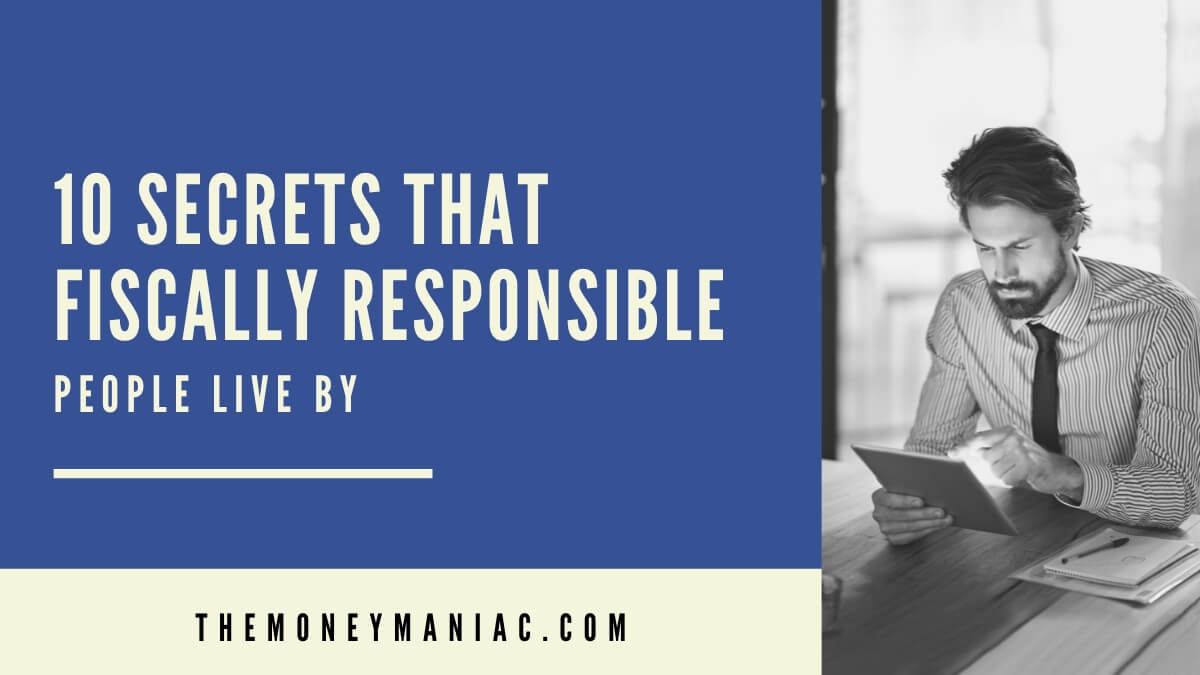Does money stress keep you up at night? If so, it might be time for you to explore the secrets of fiscally responsible people.
With nearly 70% of Americans feeling stressed due to inflation, economic uncertainty, and rising interest rates, it can seem like an uphill battle to get control of your finances.
And while some think fiscal responsibility means depriving yourself of the things you love, nothing could be further from the truth. Instead, it’s a way to take back control of your life and your money. In turn, you can speed up the process of reaching your financial goals and living the life you’ve always wanted.
So no matter your income level, these ten secrets can transform your relationship with money —from a place of worry and anxiety to one of hope and excitement.
What Does It Mean To Be Fiscally Responsible?
Being fiscally responsible is all about living within your means. It requires spending less than you earn and using the difference to save and invest for the future.
It’s about understanding that money is a tool — not a source of joy or stress. That way, you can use it to achieve your goals in life such as buying a house, taking an amazing vacation, or achieving financial freedom.
By living in this way, you will stop feeling financial stress and you will start developing the skills and mindset to make wise financial decisions.
Why Fiscal Responsibility Is Important
When you spend above your means, you put your present and your future at risk. In many cases, you may even put your family’s financial future at risk.
You will not only experience the anxiety of living paycheck to paycheck, but you will also be one crisis away from financial ruin. If a medical emergency comes up, your car breaks down, or you lose your job, it could spell disaster.
When you are fiscally responsible, on the other hand, you put yourself (not chance) in the driver’s seat. You can create a cushion between you and the potential for financial hardship. And you can be proactive in protecting yourself from life’s inevitable curveballs.
10 Secrets On How To Become Fiscally Responsible
If you are ready to make a change and embrace fiscal responsibility, here are 10 strategies to get you on track:
1. Create A Plan And Stick To It
The first step in becoming more fiscally responsible is to create a plan that includes your short and long-term financial goals.
Short-term goals are those you can accomplish in less than a year. Some examples include:
- Making a budget
- Paying off a debt
- Creating an emergency fund
As you write these goals down, be sure to include a target date for each. And then hold yourself accountable to accomplish them in time. These deadlines create the urgency and pressure we need to operate at our best.
Next up are long-term goals. These might include:
- Reaching financial independence
- Becoming debt-free
- Reaching $x in monthly passive income
Next, physically write these goals down. Not in your iPhone or an email — write them down on a whiteboard in your office, a Post-it note by your bedside, or on a piece of paper in your wallet. Keep these goals visible and refer to them often. They will remind you where you are headed and help you stay focused in working toward them for years to come.
Now that you have a plan, create a budget that outlines exactly how you will get there.
Fiscally responsible people don’t deal with vague numbers — they work with specifics. So be brutally honest about your income and expenses. And as you create your budget, remember to plan for savings and debt reduction.
Finally, check back every month to review your performance. Compare your actual expenses to your budget and give yourself a grade. Use this regular feedback to keep improving every following month.
2. Start An Emergency Fund
No matter how well we plan, the unexpected is bound to happen. Luckily, when a surprise strikes, an emergency fund can protect your savings and prevent you from tapping into high-interest debt.
How much should you set aside? Most financial advisors recommend three to six months’ worth of living expenses. And I would suggest keeping this money in a high-yield savings account. Many online-only banks are now offering interest rates comparable to CDs but without time restrictions.
Just be sure not to touch this fund for anything other than a genuine emergency. And no, a vacation doesn’t count! (For that, consider a sinking fund.)
3. Pay Off Bad Debt
Do you know the difference between good debt vs. bad debt?
Good debt is when you use a loan to buy an asset, such as a business, real estate, or further your education. Then, as the investment (or your income) grows, your financial situation improves. This is a classic example of using other people’s money to create wealth.
However, you’re taking on bad debt when you borrow money to buy a depreciating asset or consumable item. Credit cards, car payments, and payday loans are all prime examples. By carrying these debts for too long, you quickly run the risk of owing more than you can afford to pay.
For example, suppose you have a $10,000 credit card balance at a 25% annual interest rate. If you make the minimum monthly payment (assume 2% of your balance), you will never pay off the balance. In fact, your monthly payment and the interest you accrue will grow every single month.
And that’s without you making any additional purchases!
Part of being fiscally responsible is eliminating this bad debt as quickly as possible. And a great technique is the debt avalanche method. Rather than trying to pay a little extra on all your debts, focus on your highest-interest-rate loan first while making minimum payments on the rest. Then once it’s paid off, move on to the next most expensive, and so on.
You’ll find that as you apply this method, your momentum builds, just like an avalanche, and before you know it, you will be debt-free.
4. Know Your Credit Score
Lenders and insurance companies use your credit score to determine your creditworthiness. The higher your score, the lower your perceived risk. So a strong score can help you qualify for better terms. And on the flip side, a low score can mean higher rates and higher monthly payments.
Each of the three major credit bureaus collects data on your payment history, available credit, credit mix, recent inquiries, adverse credit issues (bankruptcies, judgments, collections, and foreclosures), and the age of your accounts. Then, they use these inputs to calculate your score.
Drastic changes in your credit score can affect your ability to borrow money, so fiscally responsible people make it a habit to check their score regularly.
Many banks and credit card companies now offer free credit score tracking, and some even provide your score on your monthly statements. However, you can also check it with a free online credit score service, such as credit.com or creditkarma.com.
Your score can range from 300 (Houston, we have a problem) to 850 (Hey now, I’m a rockstar). But any score over 670 is considered “good.”
If you find yourself below this mark, you can improve it with these simple steps:
- Make payments before the due date
- Increase your available credit
- Keep your oldest accounts open
- Use a mix of credit types, including car loans, credit cards, ARMs, and installment loans
- Avoid making any credit inquiries three months before applying for a new loan
5. Invest Your Money
“Compound interest is the eighth wonder of the world. He who understands it earns it. He who doesn’t pays it.” – Albert Einstein
When you invest your money, you put it to work through the power of compounding. For example, if you save $250 per month, after ten years, you would have $30,000. But if you invest that money at a 10% compound interest rate, you would have more than $51,000!
Over $21,000 more without any additional effort — that’s the power of compounding.
One of the easiest ways to get started investing is through your employer’s 401k plan or an IRA account. This way, not only are you building for a secure retirement, but you are also enjoying the benefits of tax-deferred growth (or tax-free growth in the case of a Roth IRA).
Inside these accounts, a few strategic investments worth considering include dividend-paying stocks, REITs, and ETFs. And if you’re not at retirement age yet, reinvest this dividend income to grow your wealth even faster.
6. Utilize Tax Planning Strategies
After housing, taxes are the next biggest expense for most Americans. So it’s essential to create a tax optimization plan to preserve your wealth. After all, every dollar you save on taxes can be used for your investments, moving you that much closer to financial independence.
Here are a few strategies to reduce your tax liability:
Tax-loss harvesting: This is a strategy in which you sell a losing investment to lock in your loss (or gain). The IRS allows you to deduct up to $1,500 (or $3,000 for married couples) in investment losses per year. In addition, you can carry losses forward if they exceed the limits. For example, if you lose $5,000 on a stock investment, you can deduct $3,000 the first year and $2,000 the following.
Retirement account contributions: Contributions to traditional 401k and IRA plans can lower your tax bill. These contributions reduce your taxable income dollar for dollar, as long as you adhere to these IRS limitations.
Health savings accounts: If you have a high-deductible health care plan, consider opening a health savings account. An HSA allows you to pay for medical, pharmacy, dental, and vision expenses with pre-tax dollars. Plus, any remaining balance can be invested and carried forward to the following year indefinitely.
7. Diversify Investments Strategically
Every investment carries risk, and the fiscally responsible know that putting all of your eggs in one basket isn’t wise. Rather than betting on one or two stocks, a diversified portfolio allows you to minimize volatility and better weather market downturns.
As we’ve seen this past year, stocks have suffered while fixed-income assets like bonds and high-yield savings accounts have done well. By allocating your funds between different asset classes, you can enjoy the best of both worlds and reduce your overall risk.
As you look to diversify your portfolio, consider the following investments:
- Broad market ETFs
- Growth stocks
- Income stocks
- Real estate and REITs
- Gold and other commodities
- Bond ladders
- Blue chip cryptocurrencies
So what does diversification look like?
According to this Harvard Business School study, you can effectively diversify your portfolio using these three strategies:
- Individual Asset Diversification: Invest in different assets within an asset class. For example, buying an index fund instead of an individual stock.
- International Market Diversification: Invest in foreign markets through an international or emerging-market ETF.
- Asset Class Diversification: Invest across different asset classes, such as stocks, bonds, real estate, and commodities.
As you diversify, a good rule of thumb is to avoid holding more than 5% in any one individual investment.
8. Create Multiple Income Streams
Do you have a special skill or passion? If so, you can leverage it to create another source of income. And in doing so, you can reduce your dependence on your job. This will provide security, peace of mind, and eventually a larger nest egg.
And with the internet, your income opportunities are endless! For a great place to start, check out how easy it is to make passive income on Amazon.
A few other worthwhile ideas include:
- Starting a blog
- Creating a course
- Becoming an affiliate marketer
- Renting a spare room on Airbnb
- Running a vending machine business
With a little bit of creativity, you can turn a few hours per week into an additional income stream. And as you gain experience, you can scale your operations or streamline them to buy back your time. Eventually, if these sources can replace the income from your current job, you can achieve the ultimate dream of financial freedom.
9. Get The Right Insurance
No one said insurance is sexy or exciting. And hopefully, you’ll never need it. But that doesn’t mean it isn’t an important part of being fiscally responsible. Without insurance, you run the risk of financial ruin from unexpected events or disasters.
Besides the obvious (auto and homeowners’ insurance), here are a few other policies you might want to take out:
Long-term disability insurance: This type of insurance pays out if you become injured or disabled and can’t work. This insurance is especially important if you’re self-employed.
Life insurance: If your family depends on your income, consider getting a life insurance policy. This will provide them with the necessary support if you’re no longer here.
Liability insurance: Most auto and homeowner’s insurance policies provide liability coverage, but they come with limits. If you have significant assets, consider getting additional liability insurance to protect you from claims resulting from injuries and damage to others.
10. Plan For The Future
As the saying goes, death and taxes are the only two guarantees in life. Although contemplating your demise isn’t pleasant, fiscal responsibility stretches beyond this lifetime.
A will ensures that your wealth is passed on to your loved ones according to your wishes. Because if you die without one, the state gets to decide how your assets are divided. Online programs, like Quicken’s Willmaker or Legal Zoom, make creating a will fast and easy. But of course, you can always turn to a local estate attorney as well.
Another important document, your living will, outlines the type of care you want to receive if you were to become incapacitated or terminally ill. Without it, your doctors will lean on your closest family members to make decisions. And this can create an unnecessary burden for them during a difficult time. Plus in some states, it could even fall on the courts to determine what kind of care you should receive if you don’t have a living will.
Keep in mind that your will is often not a “set it and forget it” document. As your financial situation evolves, updating your will every few years can be worthwhile.
Related reading: 21 Personal Finance Ratios That Will Boost Your Financial IQ
Final Thoughts
Being fiscally responsible isn’t about having a grandiose plan, but rather reshaping your mindset for how you approach everyday decisions.
As you embrace each of the 10 secrets above, you will find yourself closer and closer to reaching your financial dreams. And before you know it, making financial decisions will become easy.
You will feel confident that you are acting in your best financial interests. And instead of feeling stressed, you will discover how liberating fiscal responsibility can be.



